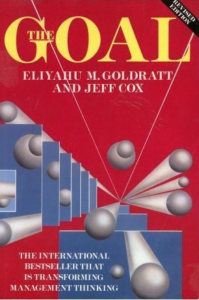To complement our series of QuickReads covering measurement, we will now explore Failure Demand (FD).…

ChangeWise Quick Reads: Theory of Constraints (ToC)
In this Quick Read, we take a high-level look at The Theory of Constraints (ToC). We explore where it comes from, the theory behind it, how to implement successfully, and the benefits of using this technique.
Where did the Theory of Constraints originate?
ToC is a management philosophy introduced by Eliyahu M Goldratt in his 1984 book titled The Goal. It is an approach to managing business operations within an organisation.

What is Theory of Constraints?
ToC argues that since it is not always possible to evenly distribute work throughout a process, a system will be limited in achieving more of its goals by a very small number of ‘constraints’ or ‘bottlenecks’.
How do I implement ToC?
- Identify where the bottlenecks/constraints exist. These are the areas that hinder the delivery of your organisational goals to the customer.
- Exploit the constraint and the factors that hinder the achievement of goals to ensure you are managing the constraint efficiently and using resource effectively.
- Subordinate every other decision to the bottleneck. The idea is that all processes that are not bottlenecks have some slack to support the bottleneck. For example, to improve the performance of the bottleneck, any process steps before the constraint must be managed to ensure they do not overload the bottleneck and further impact timings.
- Elevate the bottleneck. Most people apply this first by adding more people, machines, training, tools etc. However, this should only happen when all the ‘free’ improvements have been finished.
- Repeat. As one constraint is eliminated, it is likely that another constraint will arise (often the bottleneck shifts to a different process step). When this occurs, the organisation moves its attention to the new constraint. This process repeats itself to allow continuous improvement.


What are the benefits of applying Theory of Constraints?
ToC can significantly improve your capacity to create more product, reduce lead times, inventory and work in progress. This will ultimately increase profit. By focusing all your attention on one critical area, you can make improvements quickly and create a smooth process flow. Each bottleneck removed allows the whole process flow rate to be increased, i.e. the Takt time can be raised.
In Summary
ToC is a technique for identifying the most important constraint (or bottleneck) that limits or impacts organisational goals. All effort is then focused on the constraint until it is no longer the limiting factor. The ToC process is repeated to achieve continuous improvement.
Successful application of ToC will deliver many benefits that ultimately improve customer satisfaction and increase profit.
Want to know more about how Theory of Constraints could help your organisation? Contact us at info@changewise.co.uk
ChangeWise believes employee engagement is the foundation for successful Change. Training and coaching your people to use simple continuous improvement techniques will enable your organisation to continuously adapt and stay ahead in a constantly changing and challenging environment.
For updates and interesting Lean Change insights, connect with us on LinkedIn.
Find out more about our Public Training Courses



